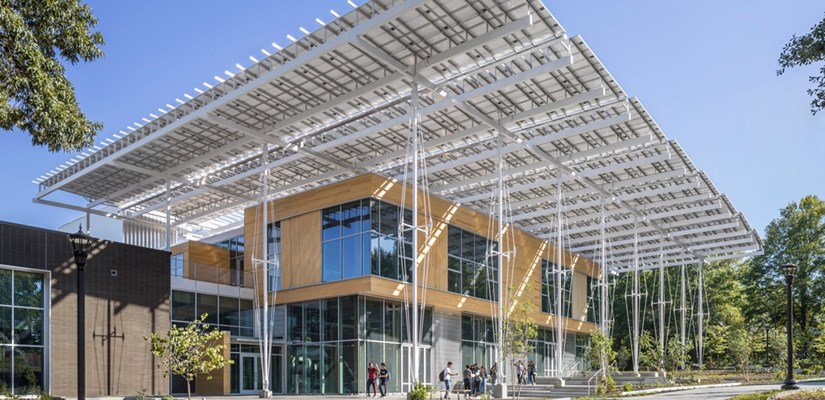
The Kendeda Building for Innovative Sustainable Design, built by Skanska USA, has earned Living Building Challenge certification, a holistic green building achievement. The certification from the International Living Future Institute independently verifies that the Kendeda Building is among the greenest in the world.
The Living Building Challenge (version 3.1) requires a 12-month performance period, during which time the project must prove it is net-positive for energy and water. This means it generates more energy from onsite renewable sources than it uses. The building also collects and treats more rainwater onsite than it uses for all purposes, including for drinking.
Meeting all seven Petals in the Living Building Challenge — Place, Water, Energy, Health + Happiness, Materials, Equity and Beauty — the Kendeda Building is the first Living Certified building of its scale in the Southeast U.S., where a warm humid climate poses many challenges. In spite of this, over the performance period the building generated 225% of the energy needed to power all of its electrical systems from solar panels on its roof. It also collected, treated and infiltrated 15 times the amount of water needed for building functions.
The project’s goal is to support the educational mission of Georgia Tech, while transforming the architecture, engineering and construction industry in the Southeast U.S. by advancing regenerative building and innovation, and by showcasing synergies between environmental stewardship, social equity and economic development. Regenerative buildings create more resources than they use, including energy and water. Through the act of creating buildings that are regenerative, Georgia Tech is charting a path for others to reverse climate change, support human health and address social inequalities.
The Living Building Challenges consists of seven performance categories called Petals that are subdivided into 20 Imperatives, which must be met to earn the certification. Performance metrics from the Kendeda Building include the following:
- Energy-efficient electrical and mechanical equipment, a tight building envelope, with a 330 kilowatt photovoltaic canopy that supplies 225% of the building’s energy needs on an annual basis.
- The photovoltaic canopy shades the building and captures rainwater. The water is stored in a 50,000 gallon cistern in the basement, before being treated and used for all purposes, including drinking.
- The building is composed of materials screened for hazardous “Red List” chemicals, such as bisphenol A, halogenated flame retardants, phthalates and formaldehyde. Chemicals on the Red List have been shown to harm human and environmental health, even though they are common in most buildings.
- Wood from sustainably managed forests, salvaged materials and other sourcing strategies significantly reduce the building’s embodied carbon emissions.
- By eliminating 99% of its construction waste and incorporating reclaimed locally sourced materials, such as reclaimed wood for the structural decking and salvaged slate tile in the restrooms, the project diverted more waste from the landfill than it sent to the landfill.
- Composting toilets nearly eliminate potable water use for sewage conveyance and allow for human waste to be turned into fertilizer for use offsite.
- The building allows for universal access. Its central feature is an accessible ramp connecting the terraced main floor so that all people have a similar experience throughout the project.
The design and construction team went above and beyond the Living Building Challenge Equity Petal by promoting an equitable and inclusive sense of community. To build the ceiling panels and floor systems, for example, the general contractor partnered with Georgia Works!, a nonprofit helping chronically homeless men become self-sufficient.
Regenerative design is resilient and supports carbon neutrality, helping to fight climate change. In a region challenged by flooding and drought, the Kendeda Building also shows that regenerative design can treat stormwater, conserve potable water, lower the risk of downstream flooding, reduce burden on existing infrastructure and save money on utilities.
At $544 per gross square foot, the Kendeda Building is 13% more expensive than a comparable building at Georgia Tech. However, in reality, there are few comparable buildings of this type that include the infrastructure for net-positive energy and water in the construction cost.
The knowledge and processes of the Kendeda Building are already being translated to other projects. Thousands of people have toured the project, the entire design and construction team have learned deep sustainability lessons throughout the life of the project, and the students and administrators who inhabit the building on a daily basis will all take these lessons out into the world and apply them to their future projects.
The Kendeda Building’s achievement was celebrated at Living Future ‘21, a virtual gathering of architects, contractors and product designers.


 Join our thriving community of 70,000+ superintendents and trade professionals on LinkedIn!
Join our thriving community of 70,000+ superintendents and trade professionals on LinkedIn! Search our job board for your next opportunity, or post an opening within your company.
Search our job board for your next opportunity, or post an opening within your company. Subscribe to our monthly
Construction Superintendent eNewsletter and stay current.
Subscribe to our monthly
Construction Superintendent eNewsletter and stay current.